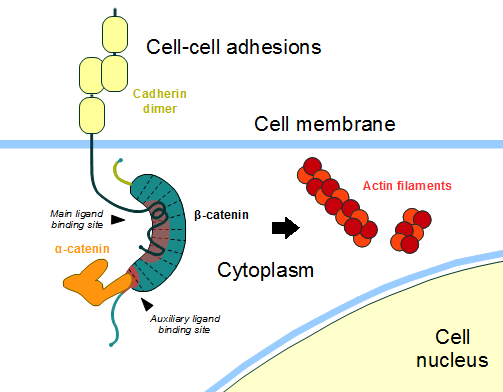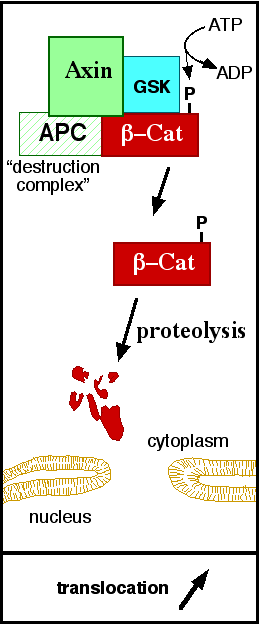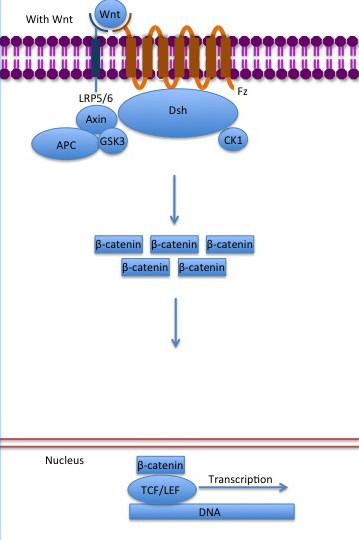User:Isabela Fonseca de Oliveira Granha/Sandbox 1
From Proteopedia
(Difference between revisions)
| Line 1: | Line 1: | ||
=ß-catenin= | =ß-catenin= | ||
| - | |||
ß-catenin is an important element in cell-cell adherens junctions, called cadherins. Reported in all Eukaryota ([https://en.wikipedia.org/wiki/Eukaryote Eukaryota]) phylum, in humans the gene CTNNB1 ([https://www.ncbi.nlm.nih.gov/gene/1499 CTNNB1]) transcribes a 95kDa protein that allows cadherins to anchor in cytoeskeleton (actin filaments) by connecting cytoplasmic proteins. Besides that, it is an essential regulator of the canonical Wnt pathway <ref name=logan&nusse2004> DOI : 10.1146/annurev.cellbio.20.010403.113126</ref> (related to embryonic development). Disturbance of this activity is associated with cancer and other diseases. Therefore, ß-catenin is an important target for developing medication for many diseases, with considerable interest in its structure. <ref name="xing2009">DOI 10.1016/j.str.2007.12.021</ref> | ß-catenin is an important element in cell-cell adherens junctions, called cadherins. Reported in all Eukaryota ([https://en.wikipedia.org/wiki/Eukaryote Eukaryota]) phylum, in humans the gene CTNNB1 ([https://www.ncbi.nlm.nih.gov/gene/1499 CTNNB1]) transcribes a 95kDa protein that allows cadherins to anchor in cytoeskeleton (actin filaments) by connecting cytoplasmic proteins. Besides that, it is an essential regulator of the canonical Wnt pathway <ref name=logan&nusse2004> DOI : 10.1146/annurev.cellbio.20.010403.113126</ref> (related to embryonic development). Disturbance of this activity is associated with cancer and other diseases. Therefore, ß-catenin is an important target for developing medication for many diseases, with considerable interest in its structure. <ref name="xing2009">DOI 10.1016/j.str.2007.12.021</ref> | ||
| Line 7: | Line 6: | ||
==Structure== | ==Structure== | ||
| - | |||
The zebrafish ([https://pt.wikipedia.org/wiki/Danio_rerio ''Danio rerio'']) <scene name='84/848919/Betacateninacoloridaartigo/2'>ß-catenin</scene> ([http://www.rcsb.org/structure/2Z6G 2Z6G]) contains residues 126-681 and a central core of <scene name='84/848919/Armrepeatsdomain/1'>12 armadillo repeats domain</scene> and an alpha helix, the <scene name='84/848919/C-helix3correta/1'>helix-C</scene>, at the beginning of the ß-catenin C-terminal domain. The armadillo domain is made of three helices in each repeat and has a particular site which is positively charged, constituting the <scene name='84/848919/Armbidingsurface/1'>binding surface</scene> for the majority of ß-catenin ligands. <ref name="xing2009" /> | The zebrafish ([https://pt.wikipedia.org/wiki/Danio_rerio ''Danio rerio'']) <scene name='84/848919/Betacateninacoloridaartigo/2'>ß-catenin</scene> ([http://www.rcsb.org/structure/2Z6G 2Z6G]) contains residues 126-681 and a central core of <scene name='84/848919/Armrepeatsdomain/1'>12 armadillo repeats domain</scene> and an alpha helix, the <scene name='84/848919/C-helix3correta/1'>helix-C</scene>, at the beginning of the ß-catenin C-terminal domain. The armadillo domain is made of three helices in each repeat and has a particular site which is positively charged, constituting the <scene name='84/848919/Armbidingsurface/1'>binding surface</scene> for the majority of ß-catenin ligands. <ref name="xing2009" /> | ||
| Line 16: | Line 14: | ||
==Cell Adhesion== | ==Cell Adhesion== | ||
| + | In the absence of Wnt stimulus, ß-catenin is located at the cytoplasmic side of the membrane as a component of cadherin-based cell-cell connections (Figure 1). [[Cadherin|Cadherins]] are transmembrane glycoproteins calcium-dependent that mediate cell-cell adhesion through link specially to ß-catenin by their cytoplasmic tails. The cadherin-catenin complex forms adherens junctions that polarize epithelial tissues and hold the cells together. However, in case of some tumor metastasis, that complex is reported as disrupted: in order to become more migratory, epithelial cells must loose their characteristic polarity, thus the complex might be affected (phenomenon described as 'cadherin switching' in epithelial-to-mesenchymal transition, EMT).<ref>Developmental Biology . Eleventh Edition. By Scott F. Gilbert and Michael J. F. Barresi. Sunderland (Massachusetts): Sinauer Associates. ISBN: 978-1-60535-470-5. 2016. </ref> | ||
| - | + | The most known interaction occurs between <scene name='84/848919/Beta-catenin_e-cadherin/3'> ß-catenin and E-cadherin</scene>, epithelial cadherin (the ß-catenin residues 134–671 are represented in green and the residues 577–728 of the mature E-cadherin sequence are colored in rose. The proteins are from ''Mus musculus'') (1I7X). They are associated while still in the endoplasmic reticulum and interfering with the binding of these proteins results in proteasomal degradation of the cadherin. First, alpha-catenin binds to ß-catenin at the first ARM repeat, amino acids <scene name='84/848919/Corretoam118-149/1'>118-149</scene>, resulting in an alpha-catenin/ß-catenin heterodimer. This binding stabilizes ß-catenin in the hinged form, and E-cadherin can connect simultaneously. The <scene name='84/848919/Surfacebeta-catenin_e-cadherin/2'>interaction surface is extensive</scene>, covering the entire length of the ß-catenin ARM repeat domain and involving the C-terminal 100 residues of the cadherin cytoplasmic domain. <ref name="valenta2012">DOI 10.1038/emboj.2012.150</ref> <ref name="huber2001">Huber, A. H., & Weis, W. I. (2001). The structure of the β-catenin/E-cadherin complex and the molecular basis of diverse ligand recognition by β-catenin. Cell, 105(3), 391-402.</ref> | |
| - | + | ||
| - | The most known interaction occurs between <scene name='84/848919/ | + | |
[[Image:Beta-catenin-moonlighting.png]] | [[Image:Beta-catenin-moonlighting.png]] | ||
| Line 31: | Line 28: | ||
==DNA binding and transcription== | ==DNA binding and transcription== | ||
| - | |||
The inhibition of ß-catenin destruction complex through activation of the Wnt pathway (Figure 3) leads to increased levels of the protein in cytoplasm and its translocation into the nucleus. ß-catenin interacts with different nuclear pore complex components and ARM repeats <scene name='84/848919/R10-12/1'>R10-R12</scene> are critical for its import and export. [[Forkhead box protein|FoxM1]] also facilitates its nuclear translocation directly interacting with ARM repeats <scene name='84/848919/R11-12/2'>R11-R12</scene>. [[Forkhead box protein|FoxM1]] forms a complex with ß-catenin/TCF on the promoters of Wnt target genes. Once in the nucleus, ß-catenin and its DNA binding partners can activate transcription of Wnt/ß-catenin target genes. Therefore, ß-catenin can only initiates transcription in a multimeric complex, as its central transcriptional activator. <ref name="valenta2012" /> | The inhibition of ß-catenin destruction complex through activation of the Wnt pathway (Figure 3) leads to increased levels of the protein in cytoplasm and its translocation into the nucleus. ß-catenin interacts with different nuclear pore complex components and ARM repeats <scene name='84/848919/R10-12/1'>R10-R12</scene> are critical for its import and export. [[Forkhead box protein|FoxM1]] also facilitates its nuclear translocation directly interacting with ARM repeats <scene name='84/848919/R11-12/2'>R11-R12</scene>. [[Forkhead box protein|FoxM1]] forms a complex with ß-catenin/TCF on the promoters of Wnt target genes. Once in the nucleus, ß-catenin and its DNA binding partners can activate transcription of Wnt/ß-catenin target genes. Therefore, ß-catenin can only initiates transcription in a multimeric complex, as its central transcriptional activator. <ref name="valenta2012" /> | ||
Revision as of 19:06, 9 July 2020
ß-catenin
ß-catenin is an important element in cell-cell adherens junctions, called cadherins. Reported in all Eukaryota (Eukaryota) phylum, in humans the gene CTNNB1 (CTNNB1) transcribes a 95kDa protein that allows cadherins to anchor in cytoeskeleton (actin filaments) by connecting cytoplasmic proteins. Besides that, it is an essential regulator of the canonical Wnt pathway [1] (related to embryonic development). Disturbance of this activity is associated with cancer and other diseases. Therefore, ß-catenin is an important target for developing medication for many diseases, with considerable interest in its structure. [2]
| |||||||||||



